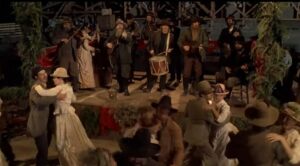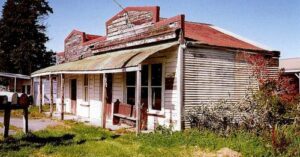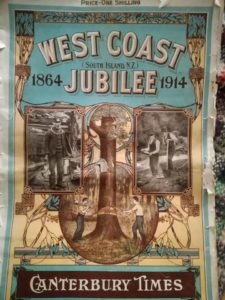1912: The Kokatahi Band
June 3, 2022
By AHNZ

New Zealand’s Kokatahi Band resembles the 1885 one Marty McFly and Doc Brown discovered in the film Back to the Future III (image, left) and with good reason. Along with the same target time period and same instruments the sound of the movie band and the real life one are quite similar and musically pleasing. The Kokatahi are New Zealand’s oldest non-brass-based band and still performing today.
Kokatahi’s longevity and success might be owed to the fact that it started life as a post-Edwardian retro band looking back on the late 1800s from the 1910s. In their own time they were already a renaissance novelty act rather than presenting themselves or offering a musical set contemporary to World War 1 times.
Leading up to The War the was an energy for looking backwards to celebrate and consolidate ancestral strength; Pride before a Fall. James Frazer was revisiting ancient folkways by publishing The Golden Bough and Cecil Sharp was recording and reviving British folk songs to great public interest. This heritage-minded wave included New Zealand which was now old enough as a country to have some history to look back on. This was the same nostalgic energy and interest in folk arts that visited us again in the 1930s and 1960s eg. Bob Dylan and The Seekers overseas and eg. Phil Garland and Rona Bailey here.
 This New Zealand revival wave was looking back to times like the 1860s Gold Rush and places like Charleston with its 80 hotel-pubs. Back in those days the hotel was the political hub of the community where political decisions were made, contracts struck, judges held court, goods warehouses, horses replenished, information dispensed, dead bodies morgued, funerals held, alcohol served, live music played. When The State took over Barrett’s Hotel in Wellington, for example, in 1849, professional politicians were deliberately assimilating the civic nerve center of a community. A new breed of younger, Woke, Liberal New Zealanders rose up to transform and bureaucratise the old Colonial New Zealand. This was achieved by minimising the elder Pioneer Spirit and its organisational apparatus as ‘drinkers’ and ‘drunks’ in contrast to themselves who were blue-ribbon-wearing Temperance and Prohibition advocates. The older generation and their culture were swept away by the New Normal which allowed the Liberal Government a 20-year tyranny to re-make New Zealand. Even King Tawhiao (1884) and Te Kooti (1889) were impressed upon to wear the blue ribbon.
This New Zealand revival wave was looking back to times like the 1860s Gold Rush and places like Charleston with its 80 hotel-pubs. Back in those days the hotel was the political hub of the community where political decisions were made, contracts struck, judges held court, goods warehouses, horses replenished, information dispensed, dead bodies morgued, funerals held, alcohol served, live music played. When The State took over Barrett’s Hotel in Wellington, for example, in 1849, professional politicians were deliberately assimilating the civic nerve center of a community. A new breed of younger, Woke, Liberal New Zealanders rose up to transform and bureaucratise the old Colonial New Zealand. This was achieved by minimising the elder Pioneer Spirit and its organisational apparatus as ‘drinkers’ and ‘drunks’ in contrast to themselves who were blue-ribbon-wearing Temperance and Prohibition advocates. The older generation and their culture were swept away by the New Normal which allowed the Liberal Government a 20-year tyranny to re-make New Zealand. Even King Tawhiao (1884) and Te Kooti (1889) were impressed upon to wear the blue ribbon.
“..the history of our liquor laws more than anything else represents a microcosm of New Zealand social history as a whole”- 1974 Royal Commission report
By the 1910s the Liberal Generation had themselves become the elder folk and it was their turn to have young people coming of age who wanted their turn to lead the country. Liberalism was not counter-culture any more it was the status quo and that meant, in turn, that to be a Conservative rooted in Old New Zealand had gone full-circle to be punk, cool, and edgy. In 1911 the fading Liberals tried to force national prohibition but it was too late, their powers were fading and the new breed was rising. The new New Zealander was athletic, energetic, materialistic, alcohol-utilising, and claimed deeper roots to ‘true’ historical past by striking up a rapport with the old Colonial Kiwis that the Liberal Kiwis had shunted aside. The same move was used by Boomers in the 1960s to wrest hegemonic authority from their elders by laying claim to an even more ancient and authentic hereditary pedigree.
If Dominion Victimhood Culture embedded their claim to New Zealand political and social hegemony in the Liberal Legacy (eg. Ballance, Seddon, Ward,..) and Neo Gothic what was the obvious counter-reaction? The youth reached back deeper into our past to the beards, boyangs, bandannas, and booze of the rustics who came before all that and played their music instead. Ref. Neo Gothic Revival, AHNZ
“American folk music in the early 60s was driven by the need of young people to define themselves against the older generation by using this music. They were trying to prove themselves as Americans in a heartfelt 1950s fashion, using American tools, American songs—but not like their parents. They used folk music to fight fire with fire.” – Reinvigorated Heritage, The Importance of the Folk Singer in the American Sixties, John Dean (2011); Cairn.info
“This must have been highly avant-garde to New Zealanders, and the world, at the time. Of course, as always, the next generation would come to associate it with the musty old past..In their day, in Benjamin Mountfort’s day, they were the trend setters. Mountfort, the great architect of colonial Canterbury, would have acted and dressed and been regarded as super-cool in his day not some 2D Scooby Doo villain.” – 1909: Gothic Revival Hair, AHNZ
“New Zealand folk-song encompasses familiar themes, beginning with the sealers and whalers. Most songs have to do with the land, with farming or shearing, with life on the gold-fields,..A fresh interest in what remained of this heritage arose in the 1950s..a well-known broadcaster, Rona Baily, begain collecting songs throughout the next decade.” – p65 The Oxford History of New Zealand Music, J M Thomson (1991)
“Fascinating and wonderful that a song that fit the lives of 1830s whalers still fits for the people today. The old whaler’s song Wellerman has had a big popularity spike in January 2021.” – 1830s: Wellerman, AHNZ
Now we can see what an amazing thing it is to have a living relic in the Kokatahi Band that survived as an artifact of this historical cultural clash.
The Origin of the Kokatahi Band
In the isolated Colonial past New Zealand had no broadband or television or radio to bring them music so amateurs created their own. Nor was it possible to travel quickly down a paved road in a private car to attend a dance or concert 50km away as if it were nothing the way it is for us today. As much as 1980s artists lamented that ‘Video Killed the Radio Star’ (1980) or “You had your time, you had the power, you’ve yet to have your finest hour” (Radio Ga Ga, Queen (1984)) there was no innocent victim here. Radio had itself displaced the gramophone which it turn had cut down thousands of little community amateur musical groups.
For example, Clarkville, in one isolated pocket of Canterbury before radio, farmers with no ability to read music managed to coordinate together and keep time for their little band with accordion and fiddles. This is how it was all over the country and we can only guess what amazing instruments or unique songs and sounds they had and were never recorded because they’ve all faded away forever. What we do have is a tribute band in the form of the Kokatahi Band that was able to pick up a musical baton from aging hands just in time to save it from oblivion and ensure a continuity.
The Kokatahi Band, thanks to these unique circumstances, allowed a kind of New Zealand music to survive an extinction event. Like a tuatara or a notornis, the last of its species somehow endured and reproduced as if in some forgotten valley. The isolated fertile valley in question is directly west of the Southern Alps formed by the Hokitika River which was settled in about 1879 out of scrub. It was separated from civilisation (Hokitika) by mud tracks and unbridged rivers until the start of the 1900s. In fact, two of the men who came to build bridges to break the isolation, the Pickering Brothers, also formalised the community music into what became the Kokatahi Band. The lack of communications lines that had nurtured and preserved this Westland valley’s music was now being reversed which allowed it to emerge.
The timely occasion that took the fledgling local band and gave them a big audience and a reputation to keep up was the Westland Goldfields Jubilee of January 1914. Hokitika temporarily swelled with an estimated 8000 people as visitors poured in for a week of festivities and catching up with old digger mates. Ref. 1914: Westland Goldfields Jubilee, AHNZ
“Long before the Clarkville hall was built concerts and dances were held in the School. Often a play was produced and written by Mr Jesse Clothier. Mr Clothier was a keen temperance advocate and his plays usually had a moral ending, in which the evils of strong drink were brought to the notice of the audience…Invariably a dance followed the orchestra of three fiddles and one accordion being played by Obed Giles, Edward Giles, Harry Wilson and Mr A (Bert) Rich. These men, though unable to read music, played correctly and kept perfect time. Not many years ago I found among my music a book of old time tunes many of which I had heard at Clarkville dances. I played them over and found that those old timers had made no mistakes, though they had learned them by ear only.” – The Clarkville Story, Charles Brockelbank, 1954
“The pioneer women of Kowhitirangi came with their husbands between the years 1879-1882…Conditions in those times were primitive- a patch of ground would be cleared and a home build with material that was at hand, pit sawn timber, with shingle roof…From these humble beginnings have grown the twin settlements of Kowhitirangi and Kokatahi, making together the largest, best farmed and most productive farming areas on the Coast.” – p248, Women of Westland (1998)
“In the days before the introduction of radio and television, people living in scattered locations throughout the rural sector, generally liked to gather periodically and share an evening’s music. Any instrument was welcome.” – p16 Graham (2001)
 Originally they were the Kokatahi-Koiterangi Band because, like the local primary school, the band was a team effort from around the valley. The shortened name may owe the erasure of Koiterangi to The State wiping that place name from the map after its most well known resident, Stanley Graham, made a fool of everyone who hunted him. Ultimately, Graham was shot dead but not before Government threw everything but the kitchen sink at him. In death the embarrassment led to an enormous, tacky, police monument unloaded at the dead man’s old front gate and a replacement of Kowhitirangi in 1950 to obliterate the scene in the settlement previously known as Koiterangi. Ref. 1941: The Graham Manhunt, AHNZ
Originally they were the Kokatahi-Koiterangi Band because, like the local primary school, the band was a team effort from around the valley. The shortened name may owe the erasure of Koiterangi to The State wiping that place name from the map after its most well known resident, Stanley Graham, made a fool of everyone who hunted him. Ultimately, Graham was shot dead but not before Government threw everything but the kitchen sink at him. In death the embarrassment led to an enormous, tacky, police monument unloaded at the dead man’s old front gate and a replacement of Kowhitirangi in 1950 to obliterate the scene in the settlement previously known as Koiterangi. Ref. 1941: The Graham Manhunt, AHNZ
According to the (defunct) band website, “Originally called the Kokatahi-Koiterangi Band, it was set up by locals, mostly farmers with some gold miners, to entertain on Sunday afternoons which was their only day off.” Yet Frank Graham states in his 2001 book that No miner has ever been a band member. This, despite the band uniform being the same garb that the old diggers wore in its most clean and unworn variation.
The origin of the band is a bit murky but I think I can see it. The Kokatahi Hotel fire, c.1933, destroyed earliest history such that it was. However, in 1964 Harry Fulton looked back to late 1911 when the amateur musicians of the valley formed a specific band. Fulton, a tailor, and his shipmate and fellow migrant from Britain, grocer Ernie Cooper (his derelict store in image to the left was used in the earlier Mainland Cheese TV advertisements before it was pulled down,) were part of a group that cooperated to provide music for a dance in the local hall. George Pickering saw what Fulton had said published in the newspaper and chimed in with his own details, clarifying that the dance was in October 1912. Pickering, along with Toby Hende, had been part of the original nucleus that the band formed around. The following month the band left the valley for the first time ever as the guest of the Hokitika Horticultural Society. They certainly self-identified as a band now and ensured that Christmas for their community, especially the children, that year was a good one.
The band, by their own reckoning, marked by birthday cakes and a 2010 centenary concert, consider that they started up in 1910. This is based on an account offered by another old band member, Percy Crough. He says that a “jubilee” occasion that crystallised the band came in 1910 on the 50th anniversary of the purchase of the West Coast by James Mackay in 1860. While 1910 would have been a proper time to remember Mackay’s purchase I can find absolutely no mention of such an observance at the time. On the other hand, there was a huge West Coast Jubilee in 1914 and the Hokitika Horticultural Society and Kokatahi-Koiterangi Band would have been in the thick of that. Crough’s story must have gotten its jubilees jumbled up. October 1911 is the true birthday of the band.
Always Around
Not long after featuring for the week-long West Coast Jubilee, no doubt becoming appreciated and acclaimed by the nostalgic old-timers, the Great War came. So seriously did the band take themselves that they enlisted not as individuals but as a band. Several of these men did not come back from the war but the band managed to hang on.
Whenever there has been an event on the West Coast, the band has been there. When the Prince of Wales visited in 1920 the band dressed up as women. In the Roaring Twenties this was considered considered hilarious at the time not weird. However, the antics of the band may finally explain the prince’s remarks since uncovered: May 12 Keller’s Hotel, Hokitika …the wretched women were too revolting for words in fact it was a proper rustic or village crowd, though it’s the mileu we’ve been living in ever since Wellington…” Ref. 1920: “Inane Maories danced & made weird noises at me!!”, AHNZ, and 1920: Royal Prince Visit, AHNZ
“The members of the above Band who have enlisted in a body, and leave with the 19th Reinforcements, will render a programme at McLean’s Pictures TONIGHT. COME AND HEAR THE PATRIOTIC BAND.” – Greymouth Evening Star (1916); Papers Past
“..when the first World War broke out, the Band lost a number of members- young ones went overseas and the rest stayed at home to keep things going. Three or four of the original Kokatahi Band didn’t return, having given the supreme sacrifice for King and Country. Jim Woolhouse, the Band’s flute player, died at Gallipoli.” – p22, Graham (2001)

In 1954 there was a remarkable display of parochial turf protection. The Greymouth Borough Council refused to let band play in Greymouth and fundraise because they were out-of-towners!
In 1965, an Australian tour. This was topped off by another one in 1981 as part of the opening festivities of Centre-Point Tower in Sydney. Unfortunately I can’t find any pictures of that.
When Shantytown opened in 1971, they were there. When the Commonwealth Games came to Christchurch in 1974 they were there too.
When New Zealand turned 150 in 1990 the band were part of the travelling expo alongside Kuki Kea.
If the Ministry of Internal Affairs doesn’t shut them down for having real human bones as part of their line of heritage instruments then the Kokatahi Band should endure for a good while yet. This, despite their finally relenting in the 1990s to allowing women into what had been a traditionally men’s band.
—
Ref. kokatahiband.co.nz, Wayback Machine
Ref. The Kokatahi Band- 100 Years in the Making, Kwant and James (2010)
Ref. Boyangs n’ Bandannas West of the Southern Alps, Frank Graham (2001)
Image ref. Blue Ribbon; heinzhistorycenter.org
Image ref. Kokatahi grocer store in 1993, Richard Howe; West Coast Recollect
 Like Comment Share
Like Comment Share






